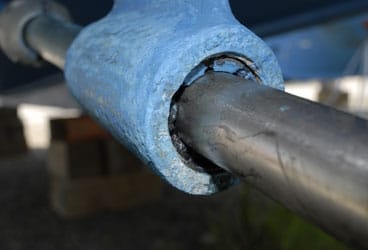
Seawater is the sole lubricant for your boat’s propeller shaft as it spins its way through life, turning thousands of rpm for hundreds upon hundreds of hours while you’re under way. The shaft is supported, typically, at its inboard end by the coupling that’s attached to the transmission; its other end is held in place by a fluted rubber tube referred to as a shaft or Cutless bearing. This bearing can be found, depending on the boat’s design, either within a shaft log that passes through the hull or in a strut some distance from the keel.
The Cutless bearing is usually made from a hard, rubberlike substance known as nitrile. Longitudinal flutes or valleys in the rubber tube are designed to improve water flow and to flush away any grit or other hard material that might wear on the shaft. The outer shell of the bearing may be made of either naval brass or a nonmetallic composite, the latter for use with aluminum struts or stern tubes where corrosion could be a problem.
Though durable, these bearings will wear out, and then they must be replaced to avoid annoying vibrations or, worse, shaft, log, or strut damage.
Removing a Cutless bearing can be challenging, particularly when it’s installed in a shaft log or keel rather than in a freestanding strut, but it’s not impossible. Start by removing the prop shaft. First, remove any setscrews or locking nuts that may be used to secure the shaft to the coupling at the transmission. (A locking nut is found inside the coupling and can’t be seen without separating the coupling from the transmission).
When you’re ready, a shaft puller/slide hammer makes shaft removal easier. If you don’t have access to one, you can insert a drift, or small metal piece—try using a socket that’s slightly smaller in diameter than the shaft—at the end of the shaft between the shaft and transmission couplings; then use long bolts to draw the two couplings back together. As you do, the socket pushes the shaft out of its recess.
With the shaft out, move on to the bearing. Loosen the setscrews that hold it in place. Then with a reciprocating saw or similar blade whose tooth count is suitable for soft wood, cut into the nitrile bearing material at one of the flutes. Continue cutting through the bearing shell, but don’t cut into the metallic strut or shaft log—this is the reason for not using a power tool. Once you’ve cut through the bearing shell, drive a brass drift between the bearing and the strut or shaft log, bending the bearing enough to grab it with pliers or Vise-Grips. Twisting and pulling will usually extract the Cutless bearing.
To install a new Cutless bearing in a strut, use a length of threaded rod that’s more than twice the length of the bearing and two squares of aluminum that are larger than the diameter of the bearing and with holes in each that are just larger than the rod. Put the rod through the bearing and use the squares as caps on either side. A little liquid soap on the outside of the bearing will help as you draw the squares together using a nut on either end.
For a shaft log, drive the bearing into place using a block of soft wood and a mallet. Finally, reinstall the bearing setscrews using blue Loctite thread-locking compound.
What is the cutless bearing life expectancy? Here are 3 signs it’s time for a new cutless bearing:
1.) You hear rumbling or vibration that slowly increases over time.
2.) If the shaft is centered in and parallel with the bearing, any movement in the shaft when it’s lifted indicates wear. (Note: An improperly aligned shaft could bind, masking the wear.)
3.) Measure the actual gap between the shaft and bearing surface. A 1.25-inch shaft should have clearances between .003 and .007 inches. Tolerances for a 1.5-inch shaft are .004 to .009 inches.








